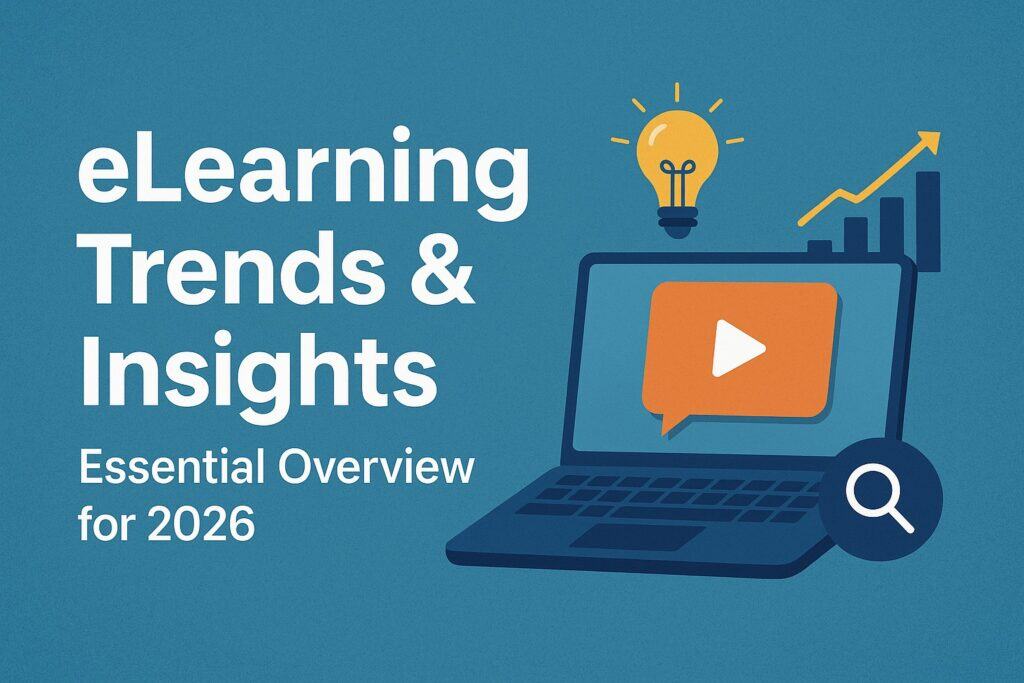As we move into 2026, the landscape of digital learning continues to transform at an accelerating pace. With advances in artificial intelligence, immersive technologies, mobile-first strategies and stronger demands for measurable impact, the way organisations and learners engage with eLearning is changing fundamentally.

- AI-Powered Personalised Learning : Smart learning systems are now moving beyond one-size-fits-all. Robust AI and machine-learning models are being used to map individual learners’ skills, preferences, performance data and career goals — enabling fully adaptive, personalised paths. In 2026, we’ll see greater deployment of AI assistants in courses: chatbots for learner support, automatic translations for global audiences, and content dynamically adapted in real time.
- Immersive & Experience-Based Learning: The next evolution of eLearning is immersive: virtual reality (VR), augmented reality (AR) and mixed-reality simulations are no longer niche pilot projects - they are becoming core training formats, especially for high-risk, technical or leadership scenarios. Differ These immersive experiences support “learning by doing”, giving learners safe environments to experiment, practise and build confidence.
- Nano-Learning & Learning in the Flow of Work: With shorter attention spans and nonstop workflows, training needs to be agile, on-demand and embedded. “Nano-learning” modules (1-3 minutes) and “Insta-learning” formats (social-feed style, mobile-first) are gaining traction. Equally, organisations are embedding learning directly into work tools (e.g., chat platforms, browsers, mobile apps) so that learning happens in the flow of work, not as a discrete event.
- Hyper-Personalisation at Scale & Data-Driven Insights: Beyond personalising content, the key differentiator is scale: systems now harness broad data sets (behavioural, performance, engagement) to optimise learning journeys for entire populations. Learning analytics and dashboards are used not just for compliance, but for predictive interventions: flagging learners at risk of disengagement, recommending next steps, and measuring real business outcomes.
- Credentials, Blockchain & Micro-Credentials: Digital credentials are evolving. With credibility and portability becoming vital, organisations are exploring technologies such as blockchain for tamper-proof credentialing and decentralised identity systems. Micro-credentials and modular skills certification are also becoming mainstream — enabling learners to up-skill rapidly without committing to full long-form programs.
- Mobile-First, Anytime Learning: Mobile devices are now the primary gateway for many learners. By 2026, a large majority of learners will expect not just mobile access, but fully mobile-optimised, interactive, engaging content. This shift means content design has to prioritise mobile-first layout, offline access, quick loading and micro-learning experiences.
- Learning Standards & Interoperability: As ecosystems mature, traditional standards like SCORM are giving way to more modern ones (for example, cmi5, xAPI) which allow richer tracking (offline, mobile) and better interoperability across platforms. Medium +1 For organisations deploying enterprise LMS, this means clearer data, better integration and less vendor-lock-in.
- Social, Collaborative & Community Learning: While individualised learning is strong, the role of peer-to-peer, cohort-based, and social learning is likewise growing. Structured social interactions, forums, mentorship and collaborative tasks build engagement, knowledge sharing and culture. eLearning Industry Learning isn’t just content delivery - it’s conversation, collaboration and community.
- Ethics, Accessibility & Learner Well-Being: With increasing scrutiny around data privacy, equity, accessibility and inclusivity, eLearning providers and organisations must embed ethical considerations into their design. Accessibility by design becomes a default, not an afterthought. Medium Learner well-being, mental resilience and soft-skills training are also becoming essential components of modern learning strategies.
- Measurable Impact & Business Alignment: Finally, in 2026 the expectation isn’t simply “learning delivered” but “outcomes achieved”. Organisations demand measurable ROI, improved performance, behaviour change and business results. Designing for impact means linking learning to key performance indicators, employee growth, retention and broader organisational goals.
Final Thoughts The future of eLearning is immersive, intelligent, mobile-first and deeply human. It’s no longer about putting content online - it’s about designing learning ecosystems that align with real business outcomes, empower every learner, and adapt as your organisation evolves.
If you're looking to stay ahead in 2026 - start by asking: How can our learning strategy support individual growth and organisational performance?
And remember: flexibility, personalisation, data-driven insights and ethical, inclusive design will be the foundations of high-impact learning.
From onboarding to compliance - TrainedIn has the solution. Get in touch with us today! Email us: Contact@trainedin.global
